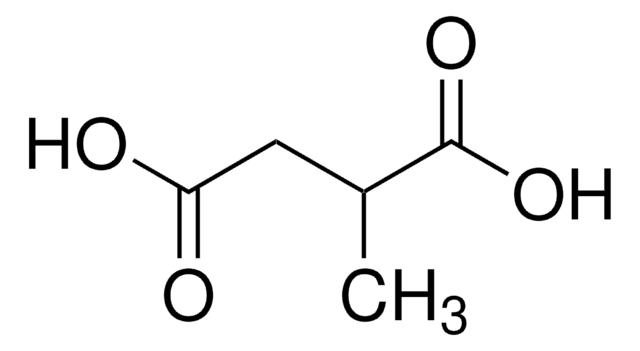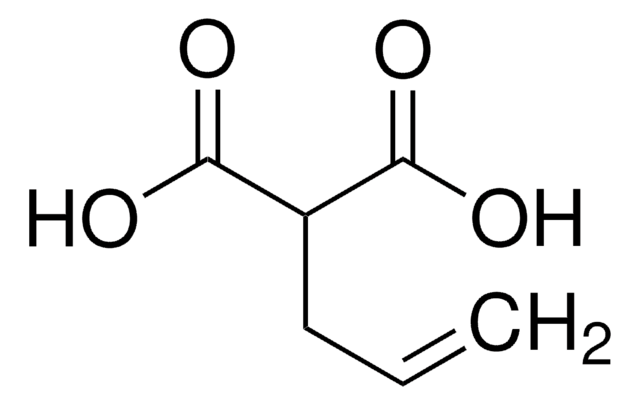102687
Ethylmalonic acid
97%
Synonym(s):
α-Carboxybutyric acid, 2-Ethylpropanedioic acid
Sign Into View Organizational & Contract Pricing
All Photos(1)
About This Item
Linear Formula:
C2H5CH(COOH)2
CAS Number:
Molecular Weight:
132.11
Beilstein:
774334
EC Number:
MDL number:
UNSPSC Code:
12162002
PubChem Substance ID:
NACRES:
NA.23
Recommended Products
Quality Level
Assay
97%
form
solid
mp
112-114 °C (lit.)
SMILES string
CCC(C(O)=O)C(O)=O
InChI
1S/C5H8O4/c1-2-3(4(6)7)5(8)9/h3H,2H2,1H3,(H,6,7)(H,8,9)
InChI key
UKFXDFUAPNAMPJ-UHFFFAOYSA-N
Looking for similar products? Visit Product Comparison Guide
Signal Word
Warning
Hazard Statements
Precautionary Statements
Hazard Classifications
Eye Irrit. 2 - Skin Irrit. 2 - STOT SE 3
Target Organs
Respiratory system
Storage Class Code
11 - Combustible Solids
WGK
WGK 3
Flash Point(F)
Not applicable
Flash Point(C)
Not applicable
Personal Protective Equipment
dust mask type N95 (US), Eyeshields, Gloves
Choose from one of the most recent versions:
Already Own This Product?
Find documentation for the products that you have recently purchased in the Document Library.
Customers Also Viewed
Patrícia Fernanda Schuck et al.
Neurochemical research, 35(2), 298-305 (2009-09-17)
High concentrations of ethylmalonic acid are found in tissues and biological fluids of patients affected by ethylmalonic encephalopathy, deficiency of short-chain acyl-CoA dehydrogenase activity and other illnesses characterized by developmental delay and neuromuscular symptoms. The pathophysiological mechanisms responsible for the
Maja Di Rocco et al.
Molecular genetics and metabolism, 89(4), 395-397 (2006-07-11)
A child is reported presenting with a clinical picture suggestive of genetic connective tissue disorders (vascular fragility, articular hyperlaxity, delayed motor development, and normal cognitive development), an absence of pathological ethylmalonic acid excretion during inter-critical phases and a homozygous R163W
Patrícia Fernanda Schuck et al.
Synapse (New York, N.Y.), 67(3), 111-117 (2012-11-20)
Ethylmalonic acid (EMA) accumulates in tissues of patients affected by short-chain acyl-CoA dehydrogenase deficiency and ethylmalonic encephalopathy, illnesses characterized by variable neurological symptoms. In this work, we investigated the in vitro and in vivo EMA effects on Na(+), K(+)-ATPase (NAK)
Carlo Viscomi et al.
Nature medicine, 16(8), 869-871 (2010-07-27)
Ethylmalonic encephalopathy is caused by mutations in ETHE1, a mitochondrial matrix sulfur dioxygenase, leading to failure to detoxify sulfide, a product of intestinal anaerobes and, in trace amounts, tissues. Metronidazole, a bactericide, or N-acetylcysteine, a precursor of sulfide-buffering glutathione, substantially
Patrícia Fernanda Schuck et al.
Behavioural brain research, 197(2), 364-370 (2008-10-28)
High concentrations of ethylmalonic acid (EMA) are found in tissues and biological fluids of patients affected by ethylmalonic encephalopathy (EE), as well as by deficiency of short-chain acyl-CoA dehydrogenase (SCAD) activity and other illnesses characterized by developmental delay and other
Our team of scientists has experience in all areas of research including Life Science, Material Science, Chemical Synthesis, Chromatography, Analytical and many others.
Contact Technical Service














